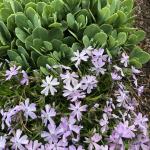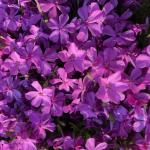A monthly e-newsletter from UMass Extension for landscapers, arborists, and other Green Industry professionals, including monthly tips for home gardeners.
To read individual sections of the message, click on the section headings below to expand the content.
To print this issue, either press CTRL/CMD + P or right click on the page and choose Print from the pop-up menu.
Be Tick Aware!
Because deer ticks have a two-year life cycle from egg to adult, last fall's nymphal ticks that have survived their first winter as unfed nymphs are beginning to emerge. Nymph emergence peaks around May and June, but it’s not uncommon to find them much earlier. Significantly, nymphs pose the greatest risk to humans, being both small and capable of spreading many diseases. Adult deer ticks become active in the fall and remain active into the following spring.
Remember...
- Nymph stage deer ticks are typically active from early May through early August.
- They are about the size of a poppy seed.
- Due to their small size, this life stage poses the highest risk of getting a tick-borne disease.
- About 1 in 4 nymph stage deer ticks carry Lyme disease.
Protect Yourself!
- Apply tick repellants (as well as flea and tick prevention for pets) whenever working or playing outdoors. EPA-registered permethrin and repellents are recommended.
- Perform tick checks after going outside.
- Check your pets for ticks after they come indoors.
- Be cautious around piled leaves along yard edges and alongside trails.
See last month's Hort Notes article The Truth About Ticks and Winter about the effects of cold temperatures on ticks.
Last Call for Photos for the 2024 UMass Garden Calendar
Ever take a great garden photo and think “this would be perfect for the UMass Garden Calendar?” UMass Extension has extended the deadline for accepting photos from the public until April 30 for possible use in our 2024 Garden Calendar. Photos must be horizontally oriented with high resolution and be of horticulturally interesting subjects. Lesser know plants that should be more widely used and appreciated are given preference. Winning entries receive recognition in the calendar and free calendars. For complete info and submission instructions, visit ag.umass.edu/gardenphotos
Featured Plant
The Pink Moon and Creeping Phlox
April’s full moon is traditionally called the Pink Moon. The name doesn’t come from the color of the moon itself but instead comes from an association with spring native wildflowers such as Phlox subulata, the blooming of which was associated with the beginning of spring. Phlox subulata is commonly referred to as moss phlox, mountain phlox, moss pinks, or creeping phlox. The common name of creeping phlox helps to illustrate the confusion of using common plant names. There are two species of phlox that can have a common name of creeping phlox, Phlox subulata and Phlox stolonifera. Both species are very similar in appearance, hence the common names being used for both. While both plants offer colorful spring flowers and have a spreading habit, there are a few key differences in telling the species apart. The first difference is height: Phlox subulata is shorter reaching only 6" in height whereas P. stolonifera can reach to about 1'. Leaves are also a distinguishing feature: Phlox subulata also has 1” long, awl-like leaves (more pointed) while P. stolonifera leaves are oblong to oval and up to 3” long. The final major difference is in sun preference. Although both plants perform well in full sun, P. stolonifera is shade tolerant while P. subulata more strongly prefers full sun. Both species are native to the eastern United States (although not as far north as Massachusetts) and prefer a well-drained, humusy soil.
Phlox subulata grows around 6” tall and spreads up to 2’ wide. Flowers are in cymes (clusters) and can range in color from light purple, red-purple, pink, and white. Individual flowers are ¾” wide and have five flat, petal-like rounded lobes that are notched. Bloom occurs in April into May. After flowering, the foliage mass resembles moss, giving it one of its common names. Trim plants back by about half after blooming to promote a denser form and potentially a light rebloom. P. subulata tolerates sandy soils and dry conditions better than other Phlox species and is also much more tolerant of powdery mildew. Plants will self seed if conditions are right. Spider mites can be a problem, especially in hot, dry conditions. Foliar nematodes can be problematic in wet and humid conditions. Rabbit damage can also be a problem. There are many cultivars that offer blue, purple, pink, red, or white flowers. Flowers are attractive to butterflies and are also visited by other insect pollinators.
Intermingled with rocks, draping over the edges of stone walls, and spreading along slopes are great sites for Phlox subulata. Sunny areas of woodland gardens, naturalized areas, and even the borders of landscape beds are also appropriate.
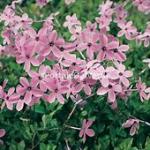 Phlox stolonifera grows up to 1’ tall and spreads to around 1.5’, but as the plant spreads by stolons, large colonies can form, essentially allowing the plant to spread until it is stopped. It also self-seeds when conditions are right. Flowers are similar in appearance to P. subulata as previously described but flower stems rise above the foliage mat and flowers are typically violet to purple. Plants have both vegetative, sterile stems with larger oval leaves (up to 3” long) and smaller, flowering stems with smaller leaves (up to ¾” long). Powdery mildew can be problematic. Cutting stems back after flowering helps reduce powdery mildew along with preventing self-seeding. Similar to P. subulata, spider mites and rabbit damage can also be problematic. P. stolonifera is at home in woodland gardens and naturalized areas. It performs well in shady pockets of flowering borders and in rock gardens.
Phlox stolonifera grows up to 1’ tall and spreads to around 1.5’, but as the plant spreads by stolons, large colonies can form, essentially allowing the plant to spread until it is stopped. It also self-seeds when conditions are right. Flowers are similar in appearance to P. subulata as previously described but flower stems rise above the foliage mat and flowers are typically violet to purple. Plants have both vegetative, sterile stems with larger oval leaves (up to 3” long) and smaller, flowering stems with smaller leaves (up to ¾” long). Powdery mildew can be problematic. Cutting stems back after flowering helps reduce powdery mildew along with preventing self-seeding. Similar to P. subulata, spider mites and rabbit damage can also be problematic. P. stolonifera is at home in woodland gardens and naturalized areas. It performs well in shady pockets of flowering borders and in rock gardens.
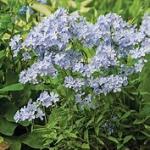 A final spring-blooming Phlox species at home in the rock garden is Phlox divaricata or wild sweet William. Like the previous two species, P. divaricata prefers a humusy, well-drained soil. However, this woodland species prefers part to full shade. A light mulch is also useful for retaining moisture and keeping roots cool in the summer. Another eastern US native (again not MA), P. divaricata is a spreading wildflower. Flowers are light purple, pink, or blue and are in clusters. Flower shape is similar to the previous species with individual flowers about 1.5” in size. Plants are also taller than the previous species, growing 12-15” tall and wide. Stems are hairy and sticky; leaves are elliptic and grow up to 2” long. Plants can form large colonies with shoots rooting to the ground at nodes. Powdery mildew is very problematic; cutting stems back after flowering helps to manage this problem. Similar to the previous species, spider mites and rabbit damage are also problems. P. divaricata is another good choice for rock gardens and naturalized areas, and is a good companion for spring bulbs.
A final spring-blooming Phlox species at home in the rock garden is Phlox divaricata or wild sweet William. Like the previous two species, P. divaricata prefers a humusy, well-drained soil. However, this woodland species prefers part to full shade. A light mulch is also useful for retaining moisture and keeping roots cool in the summer. Another eastern US native (again not MA), P. divaricata is a spreading wildflower. Flowers are light purple, pink, or blue and are in clusters. Flower shape is similar to the previous species with individual flowers about 1.5” in size. Plants are also taller than the previous species, growing 12-15” tall and wide. Stems are hairy and sticky; leaves are elliptic and grow up to 2” long. Plants can form large colonies with shoots rooting to the ground at nodes. Powdery mildew is very problematic; cutting stems back after flowering helps to manage this problem. Similar to the previous species, spider mites and rabbit damage are also problems. P. divaricata is another good choice for rock gardens and naturalized areas, and is a good companion for spring bulbs.
With the Pink Moon upon us, we can only hope that the spring blooming phlox won’t be far behind.
Mandy Bayer, PhD, Horticulturist and Landscape Plant Specialist
Trouble Maker of the Month
Verticillium Wilt
Verticillium wilt is a damaging vascular disease for an array of woody ornamentals and can be pervasive once it establishes at a site. In southern New England, native and non-native maples (Acer) are the most frequent host for the pathogen. In many cases, these trees are weakened by other landscape stresses, facilitating disease development. The most commonly observed symptoms include marginal leaf scorch, leaf wilting, vascular staining and branch dieback. Because there is a disruption of water and mineral transport to the affected branches and leaves, the symptoms appear similar to those caused by root and cankering diseases, drought, and mechanical root damage (e.g. severing, crushing or compaction). Therefore, careful examination is required to rule out these other possible stresses.
Acute foliar symptoms can develop quickly after infection and range from wilting, desiccation, marginal/interveinal browning and premature shedding of the foliage on a single branch or a particular area of the tree’s canopy. These symptoms can appear at any time during the growing season, but most often develop during hot and dry periods. More frequently, woody plants develop chronic symptoms that resemble a tree in decline, such as stunted growth, marginal leaf scorch, undersized and sparse foliage, heavy seed production and scattered branch dieback.
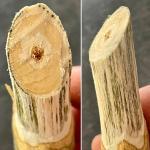 The vascular staining that results from the disease is the best diagnostic symptom for identification of Verticillium wilt and to determine if additional testing to confirm the pathogen is necessary. However, keep in mind that staining is not always present on infected trees and shrubs. Vascular staining is often olive-green in color but may range from yellow to brown, depending on the host. Because of the pathogen’s ability to move through ray cells, staining may be present deep in the xylem tissue and not in the outer vascular tissue just under the bark (where vascular staining caused by Dutch elm disease is often observed).
The vascular staining that results from the disease is the best diagnostic symptom for identification of Verticillium wilt and to determine if additional testing to confirm the pathogen is necessary. However, keep in mind that staining is not always present on infected trees and shrubs. Vascular staining is often olive-green in color but may range from yellow to brown, depending on the host. Because of the pathogen’s ability to move through ray cells, staining may be present deep in the xylem tissue and not in the outer vascular tissue just under the bark (where vascular staining caused by Dutch elm disease is often observed).
Verticillium is widespread in forest and landscape settings, yet disease incidence remains relatively low in most cases, signifying that many plants are able to resist the pathogen when attacked. For recently transplanted trees and shrubs, provide regular irrigation during extended dry periods, fertilize as needed and maintain an adequate mulch layer over as much of the root zone as possible. These activities do not have direct impacts on the pathogen itself, but they serve to enhance the tree's ability to resist infections. Reduce inoculum and improve the appearance of infected trees and shrubs by removing dead shoots and branches. Keep in mind, however, that pruning does not eliminate Verticillium from the plant since infections first establish from the roots.
At times, however, infected plants may experience a partial canopy dieback but survive and, over time, can once again flourish with proper care. Because of the soilborne nature of the fungus and its establishment within the roots, fungicides often have little to no effect. For a thorough list of resistant and immune woody plants, see page 242 in Diseases of Trees and Shrubs, 2nd ed, by Sinclair, W.A. and H.H. Lyon, 2005, Cornell University Press, Ithaca, NY.
For images and more detail, go to UMass Extension's fact shett at https://ag.umass.edu/landscape/fact-sheets/verticillium-wilt.
Nicholas J. Brazee, UMass Extension Plant Pathologist
Q&A
Q. Is English Ivy, Hedera helix, considered to be invasive in Massachusetts? What is the best way to control English ivy?
A. The Massachusetts Invasive Plant Advisory Committee (MIPAG), has completed evaluating Hedera helix for invasiveness in Massachusetts. While this species in non-native, it would likely fall short of meeting some the criteria that would designate it as invasive, likely invasive or potentially invasive. A full evaluation of this species would not likely show Hedera to 1) demonstrate the potential for rapid and widespread dispersion and establishment, 2) have the potential to disperse over spatial gaps, and 3) exist in high numbers in natural plant community and minimally managed habitats where it would be determined to be invasive or likely invasive. MIPAG defines an invasive plant as a non-native species that has spread into native or minimally-managed plant systems in Massachusetts. These plants cause economic or environmental harm by developing self-sustaining populations and becoming dominant and/or disruptive to those systems. Early during the evaluation of plant species, a well-known nurseryman in Massachusetts coined the phrase “garden thug” which appropriately describes this species' behavior in New England.
Management of a “garden thug” certainly can be justified in some situations. The timing of the most effective management strategy is important. Application of glyphosate in spring will provide good control. Application of a 41% glyphosate formulation at 4 to 5% volume per volume should be applied in the spring when the new-season growth is 3 to 5 inches long and has 3 to 5 leaves. At least two years of a spring application will likely be required for complete control.
Q. I understand that the Massachusetts Invasive Plant Advisory Committee (MIPAG) has recently evaluated some new species and has added them to the Massachusetts Prohibited Plant List. If this is true, which species have been evaluated and added to the list?
A. On November 14, 2022, the Massachusetts Department of Agricultural Resources (MDAR) added three new species to the Massachusetts Prohibited Plant List:
- Scotch Broom, Cytisus scoparius - designated as Likely Invasive
- Weeping Lovegrass, Eragrostis curvula - designated as Invasive
- Japanese Black Pine, Pinus thunbergii - designated as Likely Invasive
Implications on propagation, sale and trade - agents/growers can no longer receive new stock or begin growing new stock but may sell any existing stock during the phase out period listed below:
- Scotch Broom, Cytisus scoparius - 2 years, no longer for sale after December 31, 2024
- Weeping Lovegrass, Eragrostis curvula - 1 year, no longer for sale after December 31, 2023
- Japanese Black Pine, Pinus thunbergii - 3 years, no longer for sale after December 31, 2025
Q. I understand that dithiopyr, the herbicide in DimensionTM is a preemergence herbicide, but recently I have heard it will control crabgrass when applied postemergence. Is this accurate and what do I need to consider?
A. That is correct. In New England, where cool-season turfgrasses are the predominant species, early postemergence crabgrass control is obtained when a sprayable formulation of dithiopyr is applied prior to tiller initiation of crabgrass (1- to 5- leaf growth stage). Unlike a preemergence application, postemergence application will require the addition of a nonionic surfactant at a minimum of 0.25% v/v (2 pt per 100 gallons of spray), which will improve postemergence control if crabgrass is just past the 5-leaf stage of growth (very early first tiller). Sprayable applications of dithiopyr are a great management option should you get behind on your preemergence crabgrass applications in the spring. These applications will provide early control of the early growth stages of crabgrass while forming a preemergence barrier for subsequent crabgrass that has not yet appeared.
Randy Prostak, UMass Extension Weed Specialist
Garden Clippings Tips of the Month
April is the month to . . . .
-
Continue sowing transplants indoors. Vegetables to start indoors early this month include tomato, pepper, and eggplant; in mid- to late April, start squash, melon, and cucumber. April is also a good time to start annual ornamentals such as cosmos, zinnia, calendula, and marigold. After seedlings develop their first set of true leaves, begin fertilizing them with a solution diluted to half (or less) the product’s recommended strength; once seedlings are large enough to work with, transplant them to individual pots or cell packs to give them enough room to grow into sturdy transplants. Harden off any cool season seedlings started indoors (such as broccoli, cabbage, and cauliflower) for at least a week in a cold frame prior to transplanting into the garden.
-
Direct sow into the garden seeds of root crops such as carrot, radish, turnip, parsnip, beet, and seeds of leafy greens such as lettuce, kale, chard, and arugula. Use lightweight fabric row covers over newly sown beds to speed germination and protect tender seedlings from unpredictable spring weather. As the weather improves, remove mulch from over the emerging green tips of garlic but keep it at hand for weed control between rows/plants. Keep an eye out for hungry slugs and snails—handpick and dispose of the pests that collect underneath sheets of cardboard or wood set throughout the garden.
-
Divide perennial plants that have become too large or whose centers have become sparse (giving plants a “donut” appearance). Candidates for spring division include ornamentals that bloom in late summer or fall, such as asters, phlox, and helenium; grasses, such as miscanthus and switchgrass; and herbs, such as chives, oregano, and thyme.
-
Get a soil test! May and June are the busiest time of year for the UMass Soil & Plant Nutrient Testing Lab, so beat the rush by submitting soil samples before mid-May. The Routine Soil Analysis tests for pH, major and micro nutrients, lead, and cation exchange capacity and provides crop-specific lime and nutrient recommendations. For the order form and info on how to take and send a sample, go to soiltest.umass.edu.
-
Prune repeat-blooming roses by cutting out dead or damaged canes, removing canes that are crossing and rubbing on others, cutting off suckers protruding from grafted rootstock, and performing any additional cutbacks as needed according to the type of rose (consult a resource such as https://libguides.nybg.org/pruningroses). A pruning cut should be made just above a healthy, outward-facing bud on a sturdy cane. Slightly angle the cut down and away from the bud to allow water to run off, thereby decreasing the risk of rot.
-
Take notes and photos on the location and quantity of spring bulbs in the yard while they are blooming. This will make it easier for planning bulb purchases later in the season. Additional snowdrops are easy to acquire through division. Dig up clumps after the plants have finished flowering, while the leaves are still green. Separate the bulbs into smaller groups and replant around the yard.
-
Watch for deer ticks while working outdoors. Adults are active and can transmit a range of diseases if they become attached to and feed on unsuspecting gardeners. Take preventative measures to reduce the chance of ticks attaching, e.g., frequent tick checks; wearing light-colored, protective clothing; and treating clothes with permethrin (following label instructions). For more information, visit https://ag.umass.edu/landscape/education-events/ticktalk-with-tickreport-webinars
-
Scout for and destroy the tan, cottony egg masses of spongy moths (formerly known as gypsy moth). Oak foliage is the preferred food for spongy moth caterpillars; egg masses are often seen attached to the trunks of oak trees but may overwinter on a wide variety of plants and outdoor structures. Contact a licensed arborist for assistance if large numbers of egg masses are on or near high value trees in the landscape.
-
Include houseplants in the spring-cleaning routine. Dust leaves or wipe them with a moist cloth to maximize photosynthesis, trim off any dead stems and leaves, repot any plant outgrowing its container (or divide, if appropriate), and fertilize periodically with a half-strength solution, gradually increasing to full strength by late spring/early summer.
-
Sharpen lawn mower blades but refrain from mowing until the ground is sufficiently dry to avoid soil compaction and until grass has had an opportunity to reach a height of 3 inches or more. To support healthy root development, mow grass high (based on height range recommended for a particular species and its intended use) and do not remove more than 1/3 of the height of the lawn in a single mowing. For more information, see our UMass Extension fact sheet at https://ag.umass.edu/turf/fact-sheets/lawn-mowing
-
Consider sustainability in gardening decisions. Select plants best suited to site conditions; compost garden and kitchen waste as time, space, and community regulations permit; improve soil whenever possible (e.g., through no-till practices and adding organic matter); mulch soil surfaces to conserve water and inhibit weed growth; plant a diverse landscape as insurance against pest problems and as an invitation to humans and beneficial organisms, especially pollinators, to linger.
Jennifer Kujawski, Horticulturist
Seven Ways to Improve Pollinator Habitat
Most of us are aware that pollinator populations are in decline. We also know that wild bees, butterflies, wasps, and flies provide critical pollination services for both food crops and native plants. (You can read more about pollinator declines in the February 2022 issue of UMass Extension's Vegetable Notes). It may seem like this problem is so sweeping and complex that there’s nothing we can do to help. The good news is that the solution is relatively simple. Through decades of research, we now know that the number one cause of pollinator decline is habitat loss – that is, not enough flowering plants for pollinators to eat and too few undisturbed areas where they can nest. Preserving or establishing pollinator habitat is the most effective thing that individuals can do to support pollinators.
Because farmers, horticulturalists and land managers often oversee large tracts of land, their actions are especially impactful. Protecting or creating habitat can not only help pollinators, but also boost pollination services to crops, support natural enemies that consume crop pests, and increase the land’s environmental services, and aesthetic value.
Here are some ways to improve pollinator habitat. They are generally ordered from easiest to hardest in terms of time and expense. The good news is that “easier” habitat-improvement methods are not less impactful – ALL of these are valuable ways to support pollinators. So, if you’re inspired, do whatever is most feasible for you! Even though these tips are geared towards farmers, horticulturalists, and land managers, many are also relevant to homeowners and gardeners. At the end of the article, are some key resources to help you get started.
Protect existing pollinator habitat…
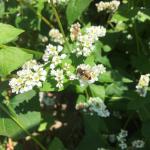 Identify and preserve existing pollinator resources. Many diversified New England farms already contain pollinator habitat on field edges or marginal/riparian areas. Any native flowering plants, shrubs or trees are excellent sources of food for pollinators, and any undisturbed soil provides a good location for nesting. By preserving these areas and protecting them from pesticide drift, you are supporting many native pollinators and other beneficial insects. If you want to be methodical about assessing existing pollinator habitat on your land, you can use this Pollinator Habitat Assessment Form and Guide for Farms or Habitat Assessment Guide for Pollinators in Yards, Gardens and Parks.
Identify and preserve existing pollinator resources. Many diversified New England farms already contain pollinator habitat on field edges or marginal/riparian areas. Any native flowering plants, shrubs or trees are excellent sources of food for pollinators, and any undisturbed soil provides a good location for nesting. By preserving these areas and protecting them from pesticide drift, you are supporting many native pollinators and other beneficial insects. If you want to be methodical about assessing existing pollinator habitat on your land, you can use this Pollinator Habitat Assessment Form and Guide for Farms or Habitat Assessment Guide for Pollinators in Yards, Gardens and Parks. - Turn marginal areas into pollinator gardens. You know those spots by the high tunnel, or beside the barn, that always grow into a weedy mess? If they are already colonized with flowering native plants, celebrate them! If not, consider turning them into micro-pollinator-gardens. As a bonus, if these spots are close to a farm stand or CSA pick-up location, they will look great to customers. Check out this list of Pollinator Plants for the Northeast from the Xerces Society for species ideas and planting tips or the Massachusetts Department of Agriculture’s list of Locally Available Pollinator-Friendly Native Plants.
Make pollinator habitat a part of your cropping plan…
- Plant pollinator-friendly cover crops. Many flowering cover crops provide excellent food for bees and other beneficial insects. These include buckwheat, clovers, peas, phacelia, sunflower, alfalfa, and mustards. Many of these cover crops are multi-functional – for instance, buckwheat is also great at suppressing weeds, and clovers help to fix nitrogen. However, it is important to note that cover crops provide bees with a burst of resources during flowering, but not season-long food or nesting locations. You can read more about cover cropping for pollinators in SARE’s Cover Cropping for Pollinators and Beneficial Insects. You can also search for pollinator-friendly cover crops using the Northeast Cover Crop Council’s species selector tool.
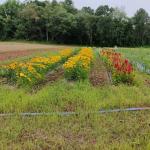 Consider adding cut flowers to your operation, and/or allow crops to flower. Many cut flowers, especially native perennial ones, provide excellent resources for pollinators. Some good examples are sunflower (and other asters), purple coneflower, foxglove, and yarrow. Food crops like brassicas, cilantro or dill are also great sources of nectar and pollen if left to flower.
Consider adding cut flowers to your operation, and/or allow crops to flower. Many cut flowers, especially native perennial ones, provide excellent resources for pollinators. Some good examples are sunflower (and other asters), purple coneflower, foxglove, and yarrow. Food crops like brassicas, cilantro or dill are also great sources of nectar and pollen if left to flower. - Practice IPM and bee-friendly pesticide use. It is not only important to preserve and/or establish flowering plants, but also to protect those flowers from pesticides. Reduce pesticide use through Integrated Pest Management (we know that most of you are already doing this!), choose pesticides with a lower bee hazard rating, and always apply pesticides in ways that reduce harm to beneficial insects (e.g. in the evening and when plants are not in full bloom). Read more about pollinator-friendly pesticide practices in the New England Vegetable Management Guide. You can also check the toxicity of pesticides for bees using this University of California IPM tool.
Establish new perennial pollinator habitat…
(Note: Farms can often receive NRCS funding to install pollinator habitat - contact your local NRCS office to learn more)
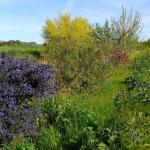 Plant a hedgerow. Flowering shrubs and trees provide amazing early-season resources for bees and other beneficial insects. They can also serve as a wind break or organic buffer, reduce erosion, or shield crops from a busy road. You can also consider boosting your hedgerow with native perennial herbaceous plants, which often flower later than trees and shrubs, providing pollinators with resources throughout the season. See this list of MA Native Trees and Shrubs for Pollinator Conservation as well as Estimated Costs to Establish Pollinator Hedgerows to get started.
Plant a hedgerow. Flowering shrubs and trees provide amazing early-season resources for bees and other beneficial insects. They can also serve as a wind break or organic buffer, reduce erosion, or shield crops from a busy road. You can also consider boosting your hedgerow with native perennial herbaceous plants, which often flower later than trees and shrubs, providing pollinators with resources throughout the season. See this list of MA Native Trees and Shrubs for Pollinator Conservation as well as Estimated Costs to Establish Pollinator Hedgerows to get started. - Sow a pollinator meadow. Another powerful way to support bees and other beneficial insects is to install a pollinator meadow. Depending on the meadow's size, it usually is most economical to start a meadow from seed. However, it is important to follow instructions carefully, and be ready to invest significant time and energy into this endeavor. Meadows can be tricky and often become overrun with weeds. They can also take a significant amount of land out of production. But if done right, they can become a beautiful asset to your land, and your local pollinators! To learn more about establishing a pollinator meadow, seet Establishing Pollinator Meadows from Seed and Organic Site Preparation for Wildflower Establishment from the Xerces Society, as well as Wildflower Meadows – Plant Selection and Establishment from the University of New Hampshire. Also check out these videos on creating Habitat for Bees from Project Integrated Crop Pollination.
Pollinator habitat resources
General resources:
- Xerces Society:
Habitat installation guides (incl. hedgerows, meadows, and cover crops):
- Project Integrated Crop Pollination:
- Videos about creating Habitat for Bees
- Xerces Society:
- University of New Hampshire: Wildflower Meadows – Plant Selection and Establishment
- USDA SARE: Cover Cropping for Pollinators and Beneficial Insects
Pollinator Plants for MA and New England:
- UNH Extension: Seed Sources for New England Meadows
- MDAR: Creating Pollinator-Friendly Gardens with Native Plants - Locally available options
- Xerces Society:
Hannah Whitehead, UMass Extension Educator
Additional Resources
For detailed reports on growing conditions and pest activity – Check out the Landscape Message
For professional turf managers - Check out our Turf Management Updates
For commercial growers of greenhouse crops and flowers - Check out the New England Greenhouse Update website
For home gardeners and garden retailers - Check out our home lawn and garden resources
TickTalk webinars - To view recordings of past webinars in this series, go to: https://ag.umass.edu/landscape/education-events/ticktalk-with-tickreport-webinars
Pesticide Exam Preparation and Recertification Courses - Contact Natalia Clifton at nclifton@umass.edu or go to https://www.umass.edu/pested for more info. Classes are held virtually.
Diagnostic Services
Landscape and Turf Problem Diagnostics - The UMass Plant Diagnostic Lab is accepting plant disease, insect pest and invasive plant/weed samples. By mail is preferred, but clients who would like to hand-deliver samples may do so by leaving them in the bin marked "Diagnostic Lab Samples" near the back door of French Hall. The lab serves commercial landscape contractors, turf managers, arborists, nurseries and other green industry professionals. It provides woody plant and turf disease analysis, woody plant and turf insect identification, turfgrass identification, weed identification, and offers a report of pest management strategies that are research based, economically sound and environmentally appropriate for the situation. Accurate diagnosis for a turf or landscape problem can often eliminate or reduce the need for pesticide use. See our website for instructions on sample submission and for a sample submission form at http://ag.umass.edu/diagnostics.
Soil and Plant Nutrient Testing - The lab is accepting orders for Routine Soil Analysis (including optional Organic Matter, Soluble Salts, and Nitrate testing), Particle Size Analysis, Pre-Sidedress Nitrate (PSNT), and Soilless Media (no other types of soil analyses available at this time). Testing services are available to all. The lab provides test results and recommendations that lead to the wise and economical use of soils and soil amendments. For updates and order forms, visit the UMass Soil and Plant Nutrient Testing Laboratory web site.
Tick Testing - The UMass Center for Agriculture, Food, and the Environment provides a list of potential tick identification and testing options at: https://ag.umass.edu/resources/tick-testing-resources.

